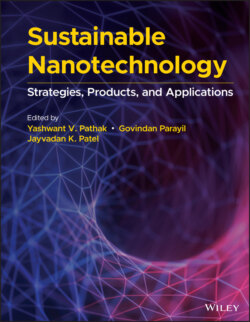Читать книгу Sustainable Nanotechnology - Группа авторов - Страница 4
List of Illustrations
Оглавление1 Chapter 2Figure 2.1 Road to sustainability in nanotechnology.Figure 2.2 Life cycle assessment of nanotechnological products.
2 Chapter 4Figure 4.1 Types of biopolymers and their source of origin.Figure 4.2 Production steps of cellulose nanosponges.Figure 4.3 Types of bionanocomposites.Figure 4.4 Applications of biobased nanotechnology.
3 Chapter 5Figure 5.1 Biopolymer classes [3].Figure 5.2 Preparation of polyhydroxybutyrate (PHB) in both biomass and oils...Figure 5.3 Fibroin is assembled from nanofibril units which crystal network ...Figure 5.4 Main proteins of silkworm silk fibers are fibroin and sericin [18...Figure 5.5 Chemical structure of chitosan biopolymer [25].Figure 5.6 Process describing evaporation.
4 Chapter 6Figure 6.1 Structure of polylactic acid.Figure 6.2 Structure of polyglycolic acid.Figure 6.3 Structure of polyhydroxybutyrate.Figure 6.4 Structure of poly lactide‐co‐glycolide.Figure 6.5 Hydrolytic degradation of PLGA.Figure 6.6 Structure of poly‐e‐caprolactone.Figure 6.7 Structure of polyanhydride.Figure 6.8 Structure of chitosan.Figure 6.9 Structure of gelatin.Figure 6.10 Structure of sodium alginate.Figure 6.11 Structure of lignin.Figure 6.12 Structure of cellulose derivatives.Figure 6.13 Structure of albumin.Figure 6.14 Structure of dextran.Figure 6.15 Structure of collagen.Figure 6.16 Structure of hyaluronic acid.Figure 6.17 Structure of starch.Figure 6.18 Structure of guar gum.Figure 6.19 Structure or agarose.Figure 6.20 Structure of silk.
5 Chapter 8Figure 8.1 Top‐down and bottom‐up approaches of nanoparticle synthesis.Figure 8.2 Biosynthesis of titanium dioxide nanoparticles.
6 Chapter 9Figure 9.1 Nanocellulose from agricultural, wood, and paper making waste sou...Figure 9.2 Synthesis of the CNS, first synthetic approach. The steps for the...Figure 9.3 SEM images of bPEI‐TOCNF (2 : 1) nanosponges at different magnifi...Figure 9.4 Synthesis of the CNS with the addition of citric acid. For the sy...Figure 9.5 (a) 2D representation of sample slice (1600 × 1600) μm2, (b) 3D r...Figure 9.6 Example of SANS data fitting with correlation length model (CLM),...Figure 9.7 (a) Hydration dependence of a short‐range correlation length ξ...Figure 9.8 Schematic representation of the eco‐design concept study develope...
7 Chapter 10Figure 10.1 Biomedical applications of nanoclays.
8 Chapter 11Figure 11.1 Schematic of horizontal solution electrospinning used for nanofi...Figure 11.2 Scanning electron microscopy (SEM) of diverse nanostructures: (a...Figure 11.3 Pore size of chitin nanofiber membrane separator (a) versus comm...Figure 11.4 CoO‐ATO nanofiber membrane.Figure 11.5 Filtration efficiency of charged and discharged one‐layered (1L)...Figure 11.6 Filtration efficiency of multilayered (1L‐4L) charged PVDF nanof...Figure 11.7 Comparison of the amount of arsenic absorbed in (a) sand (contro...Figure 11.8 (a*) and (d**) SEM, (b*) and (e**) TEM, and (c*) and (f**) AFM i...Figure 11.9 Chronoamperometric analysis of PNM glucose sensor for successive...Figure 11.10 Selectivity test for the PNM‐based glucose sensor.Figure 11.11 Elongation (%), tensile strength (MPa), and Young's modulus (MP...Figure 11.12 Electroactive PLA composite used as mechanical support for fibe...Figure 11.13 (a) PLA/polyaniline composite single fiber as the active materi...Figure 11.14 Cancer multiaxial nanofiber drug delivery as (a) through (f) sh...Figure 11.15 (a) Cross section of triaxial nanofiber horizontal view. (b) Ve...Figure 11.16 (a) Aligned multiaxial PNM and (b) random ordered PNM.Figure 11.17 Four major life cycle inventory groups.Figure 11.18 Network representation of the energy consumed in each process s...Figure 11.19 Holistic processing approach for nanofiber membrane performance...Figure 11.20 Magnetic PAN/magnetite nanofibers after (a) electrospinning, (b...Figure 11.21 Magnetic PAN/nickel‐ferrite nanofibers after (a) electrospinnin...Figure 11.22 Schematic of binary bit and qubit – two‐state quantum device [1...
9 Chapter 12Figure 12.1 Different approach of synthesis of nanoparticle.Figure 12.2 Different important phytochemicals and their mode of action.Figure 12.3 Mechanism of action of phytochemicals in biological system.Figure 12.4 Biological agents used for nanoparticle synthesis.Figure 12.5 Manipulation of different characteristic features of nanoparticl...
10 Chapter 13Figure 13.1 Polymer biocomposite classification of NBCs.Figure 13.2 Type and composition of composite materials.Figure 13.3 Polysaccharide‐based biocomposites.Figure 13.4 Cellulose‐based biocomposite preparations.Figure 13.5 Pectin‐based biocomposite preparations.Figure 13.6 Starch‐based biocomposite constituents: (a) amylase; (b) amylope...Figure 13.7 Alginate composite consists of β‐D‐mannuronic (M) and α‐L‐guluro...Figure 13.8 Mechanisms of biodegradation: (a) surface erosion; (b) bulk eros...
11 Chapter 17Figure 17.1 Various contaminants polluting the environment.Figure 17.2 Schematic representation of the mechanisms of nanoparticles in t...
12 Chapter 20Figure 20.1 (a) SEM, (b) TEM, and (c) magnified TEM images of poly(ethylene ...Figure 20.2 The effect of the different viscosities on fiber morphology: (a)...Figure 20.3 Benchmarks for designing effective drug delivery systems.Figure 20.4 Illustration of temperature‐responsive nanofiber mesh for thermo...Figure 20.5 Illustration of a burn (a) chitosan nanofiber as wound dressing ...
13 Chapter 21Figure 21.1 Sustainable green nanomedicines.Figure 21.2 Graphical representation of a mechanistic scheme showing the syn...
